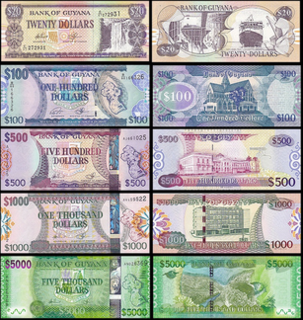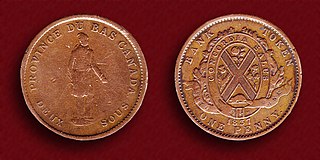The pound was the currency of Prince Edward Island until 1871. It was divided into 20 shillings , each of 12 pence . It was replaced by the dollar in 1871. Initiall sterling coin circulated, together with locally produced coins and paper money.
The only coins issued exclusively for Prince Edward Island were issued in 1813. There were two denominations, the 1/– and 5/–. Both were produced by cutting a central plug from a Spanish dollar (8 real) coin. The plug, stamped with a sunburst, made the 1/– piece, whilst the similarly stamped ring made the 5/– piece. Due to its shape, the 5/– coin was known as a holey dollar.
In 1790, the Island of St. Jean (as Prince Edward Island was then known) issued Treasury notes in denominations of 1/–, 1/6, 2/6, 5/–, 10/–, 20/– and 40/–. A further issue of Treasury notes was made between 1834 and 1870, with denominations of 5/–, 10/–, £1, £2, and £5.
Along with the Treasury notes, two chartered banks issued paper money, the Bank of Prince Edward Island which commenced operations Aug 13, 1854 [1] and the Union Bank of Prince Edward Island . However, the pounds issued by these two banks had different values relative to sterling. The Bank of Prince Edward Island issued notes in denominations of 5/–, 10/–, £1, £2 and £5 between 1856 and 1863. This pound unit was worth 13s.4d. sterling and the notes also carried the denomination in sterling (3s.4d., 6s.8d., 13s.4d., £1.6s.8d. and £3.6s.8d.). The Union Bank issued notes between 1864 and 1865 denominated in both dollars (worth 4s.2d.) and sterling. Denominations were $1, $2, $5 and $20 (4s.2d., 8s.4d., £1.0s.10d, £4.3s.4d sterling).

Sterling is the official currency of the United Kingdom and its associated territories.
The British West Indies dollar (BWI$) was the currency of British Guiana and the Eastern Caribbean territories of the British West Indies from 1949 to 1965, when it was largely replaced by the East Caribbean dollar, and was one of the currencies used in Jamaica from 1954 to 1964. The monetary policy of the currency was overseen by the British Caribbean Currency Board (BCCB). It was the official currency used by the West Indies Federation The British West Indies dollar was never used in British Honduras, the Cayman Islands, the Turks and Caicos Islands, the Bahamas, or Bermuda.

The pound was the currency of Australia from 1910 until 14 February 1966, when it was replaced by the Australian dollar. As with other £sd currencies, it was subdivided into 20 shillings, each of 12 pence.
The pound is the currency of Guernsey. Since 1921, Guernsey has been in currency union with the United Kingdom and the Guernsey pound is not a separate currency but is a local issue of sterling banknotes and coins, in a similar way to the banknotes issued in Scotland, England and Northern Ireland. It can be exchanged at par with other sterling coinage and notes.

The Guyanese dollar has been the unit of account in Guyana since 29 January 1839. Originally it was intended as a transitional unit to facilitate the changeover from the Dutch guilder system of currency to the British pound sterling system. The Spanish dollar was already prevalent throughout the West Indies in general, and from 1839, the Spanish dollar unit operated in British Guiana in conjunction with British sterling coins at a standard conversion rate of one dollar for every four shillings and twopence. In 1951 the British sterling coinage was replaced with a new decimal coinage which was simultaneously introduced through all the British territories in the Eastern Caribbean. When sterling began to depreciate in the early 1970s, a switch to a US dollar peg became increasingly attractive as an anti-inflationary measure and the Eastern Caribbean Currency Authority made the switch in October 1975. The Guyanese dollar is normally abbreviated with the dollar sign $, or alternatively G$ to distinguish it from other dollar-denominated currencies.

The dollar has been the currency of Liberia since 1943. It was also the country's currency between 1847 and 1907. It is normally abbreviated with the sign $, or alternatively L$ or LD$ to distinguish it from other dollar-denominated currencies. It is divided into 100 cents.

The dollar has been the currency of Barbados since 1935. Globally its currency has the ISO 4217 code BBD, however, unofficially in Barbados the International vehicle registration code code BDS is also commonly used, a currency code that is otherwise reserved for Bangladesh outside Barbados. As such the present dollar has the ISO 4217 code BBD. The Barbadian dollar is divided into 100 cents.

The pound was the currency of the Union of South Africa from the formation of the country as a British Dominion in 1910. It was replaced by the rand in 1961 when South Africa decimalised.
The pound was the currency of the Bahamas until 1966. It was equivalent to the pound sterling and was divided into 20 shillings, each of 12 pence. Standard sterling coinage circulated. Apart from a Bahamas penny coin struck in 1806, there were no special coin issues such as were found in Jamaica.

The pound was the currency of Fiji between 1873 and 1969. It was subdivided into 20 shillings, each of 12 pence.

The dollar was the currency of the colony and, later, Dominion of Newfoundland from 1865 until 1949, when Newfoundland became a province of Canada. It was subdivided into 100 cents.

Canada has an extensive history with regard to its currencies. Prior to European contact, indigenous peoples in Canada used items such as wampum and furs for trading purposes, which continued when trade with Europeans began.
The dollar was the currency of Nova Scotia between 1860 and 1871. It replaced the Nova Scotian pound at a rate of 5 dollars = 1 pound and was consequently worth less than the Canadian dollar. The Nova Scotian dollar was replaced by the Canadian dollar at a rate of 73 Canadian cents = 75 Nova Scotian cents, thus maintaining the difference between the two currencies established in 1860.

The pound was the currency of the Canadas until 1858. It was subdivided into 20 shillings (s), each of 12 pence (d). In Lower Canada, the sou was used, worth 1⁄2 penny. Although the £sd accounting system had its origins in sterling, the Canadian pound was never at par with sterling's pound.
The history of currency in the British colony of Dominica closely follows that of the British Eastern Caribbean territories in general. Even though Queen Anne's proclamation of 1704 brought the gold standard to the West Indies, silver pieces of eight continued to form a major portion of the circulating currency right into the latter half of the nineteenth century.
The pound was the currency of New Brunswick until 1860. It was divided into 20 shillings, each of 12 pence, with the dollar circulating at a value of 5/–.
The pound was the currency of Newfoundland until 1865. It was subdivided into 20 shillings, each of 12 pence. The Newfoundland pound was equal to sterling and sterling coin circulated, supplemented by locally produced tokens and banknotes. In 1865, the dollar was introduced at a rate of 1 dollar = 4s.2d., or 1 dollar = 50d.

The pound was the currency of Nova Scotia until 1860. It was subdivided into 20 shillings, each of 12 pence. It was equivalent to sterling and was replaced by the dollar in 1860, at a rate of $5 dollars = £1, although coins and notes of the dollar currency were not issued until 1861.

The Prince Edward Island dollar was a unit of currency used in Prince Edward Island. The dollar replaced the Prince Edward Island pound in 1872 at a rate of 1 pound = 4.866 dollars. The dollar was subdivided into 100 cents.
The dollar was the currency of British Columbia between 1865 and 1871. It replaced the British pound at a rate of 1 pound per 4.866 dollars and was equivalent to the Canadian dollar, which replaced it. The dollar was subdivided into 100 cents. No distinct coins were issued, with Canadian coins circulating.